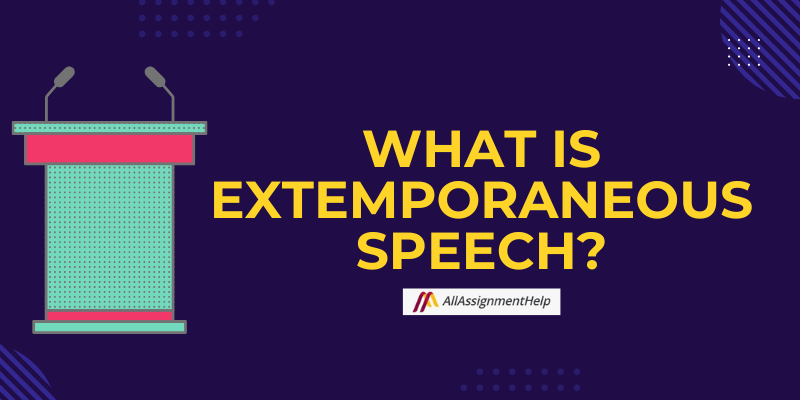Table of Contents
Have you ever had to deliver a speech or presentation with no prior notice or preparation time? This is known as an extemporaneous speech. It is a type of public speaking where a speech is given without a lot of planning or a script. Extemporaneous speaking stands out among all types of public speaking because it can be both difficult and artistic.
However, giving a speech on the spot might be intimidating, but with a little preparation and understanding of the fundamentals, you can do it with ease. In this blog of All Assignment Help, we will go over the definition of an extemporaneous speech, its benefits, and how to give an extemporaneous speech.
Well, let’s get started!
What is Extemporaneous Speech?
The term “extemporaneous” is synonymous with “impromptu” and refers to “without planning.” Extemporaneous speech, also known as impromptu speech, refers to giving a speech on a particular topic without any prior preparation. This type of speech is usually used in professional presentations, debates, and public speaking events.
An extemporaneous speech example includes when a student has been asked to speak spontaneously in front of the class about a current event.
Since extemporaneous speeches are not prepared by reading or memorization, the speaker must be able to “think on their feet” and remain in the present. This can be a difficult process. However, it also allows for quite a bit of spontaneity, which results in a conversational, organic style. A student can also take help from an online assignment helper if they are assigned an impromptu speech as a part of their extracurricular activity.
Read Here: Effective Techniques to Give an Impromptu Speech
Benefits of Extemporaneous Speech
Extemporaneous speech has a number of benefits that make it a useful and successful way to communicate. Below are the advantages of extemporaneous speech:
Improved Critical Thinking
Extemporaneous speech helps speakers develop their critical thinking skills. They have to synthesize their ideas, assess information, and arrange their thoughts fast. For example, consider a student taking part in a debate who must quickly study a topic and develop arguments.
Participation & Audience Interaction
Extemporaneous speaking keeps their audience interested by facilitating engaging conversations and asking questions. This involvement improves audience engagement and retention. For example, during a class discussion, a teacher can allow students to pose questions on the day’s subject.
Natural Delivery and Minimal Anxiety
Those who read or remember speeches precisely tend to be more anxious than spontaneous presenters. This method releases speakers from the need for strict memorization, allowing for a more organic delivery style. For example, it could be less nerve-racking for somebody to give an impromptu thank-you speech at a workplace event than to read from a script.
Strong Storytelling
Storytelling is a natural fit for extemporaneous speech as presenters can come up with stories according to the circumstances and audience reaction. For example, speaking at a fundraising event, a nonprofit representative can tell a moving narrative to inspire compassion and encourage donations. Also, those who lack the storytelling skills can take assistance from story writing assignment help from a writer to get ideas for creative storytelling.
Adaptability in Different Situations
From casual conversations to serious speeches, extemporaneous speaking can be used in a variety of contexts. It is a useful skill in social, academic, and professional settings because of its adaptability. For example, a community activist can effectively communicate their message by using the same impromptu style while speaking at a town hall meeting and a local club function.
Extemporaneous speech has several benefits that improve listener engagement, flexibility, and communication efficacy. Its realness, adaptability, and development of critical thinking skills enable presenters to engage better with their listeners and convey powerful messages in different types of contexts.

What are the Elements of an Extemporaneous Speech?
A successful extemporaneous speech combines a number of the necessary elements that enhance its overall effect. Let’s take a closer look at these elements:
A Clear and Concise Introduction
Your speech should start with a clear and captivating introduction. Indicate the topic or query at hand in clear terms and give a synopsis of your discussion. Get the audience involved right away by interacting with them. Moreover, A wise statement, a concise remark, or a popular quotation is always a fantastic starting point and captures the essence of what it takes to succeed as an extemporaneous speaker.
Properly Structured Information
Organize your speech so that it makes sense and flows naturally. Create a logical and convincing argument by combining key ideas with illustrative details. However, you can also choose to apply methods like as cause-effect analysis, chronological order, or the problem-solution approach depending on your topic.
Supporting Evidence
Support those assertions with relevant and reliable proof. Use facts, figures, examples, and stories to support your arguments and give readers a better grasp of your topic. Also, use reliable research, professional judgments, or personal experiences to give your speech legitimacy.
Engaging Delivery
Give your speech with strength, assurance, and excitement. Keep your eyes on the audience, make proper body language and gestures, and change up your voice tone. Furthermore, try to speak in a conversational manner that engages your audience personally.
A Successful Conclusion
Finish your speech with a compelling conclusion that restates your thesis statement and highlights your key arguments. Encourage the audience to think about your speech by leaving them with a call to action or a lasting impression.
Nowadays, the use of extemporaneous speaking has grown in popularity in online education. In online classes, students are often asked to share their ideas, organize debates, or take part in spontaneous speaking tasks. However, not every student is good at speaking spontaneously, especially when it comes to discussion forums. This is where online class help services came into play. Students can visit these services and ask, will you take my online class for me? These services often possess a team of online class helpers who can take care of everything related to your online classes, including extemporaneous speaking participation.
How to Give an Extemporaneous Speech?
These few guidelines can help you give an outstanding extemporaneous speech performance:
Engage Your Audience
Speaking spontaneously offers you a fantastic chance to connect with your audience. Try to look each person in the crowd in the eye while you talk. Use your natural motions and a genuine smile to highlight your arguments. Also, always change up the tempo and tone of your speech to keep your audience engaged.
However, don’t be scared to change things up if you observe that your audience is becoming disinterested. Use a visual aid, a narrative, or a question to get them interested again. Your speech will have a stronger impact if you can engage your audience more.
Use Correct Vocabulary
It might be tempting to use jargon or huge words to seem intelligent when talking spontaneously. However, using plain, uncomplicated language often proves more successful. Stay away from words that your audience could have trouble understanding and concentrate on communicating your thoughts in a style that is understandable to everybody.
Additionally, utilize emotive language to truly engage your readers. They will be more engaged with every word if you describe it in a way that makes it easy for them to visualize what you are saying.
Keep the Tone Conversational
Speaking naturally and conversationally is one of the most important aspects of excellent extemporaneous speaking. Avoid seeming like you’re repeating a screenplay that you’ve learned or reading from your notes. Instead, attempt to talk to your audience as though you were speaking to them directly.
Additionally, don’t be hesitant to express your personality, ask rhetorical questions, and apply contractions. People will relate to you and your message better if you sound genuine and approachable.
Deal with Nerves
Speaking in front of an audience might be intimidating, particularly if you are giving impromptu speeches. However, you can show confidence and relax your anxiety by doing a few things.
Slow down your breathing before you start your conversation. Take a deep breath, hold it for a moment, and then release it slowly. Repeat this a few times to reduce your heart rate and ease your anxiety. Then, attempt to reframe your anxiety as enthusiasm. Instead of worrying about what can go wrong, consider the chance to interact with your audience and express your views.
Extemporaneous speeches are common in English classes. It is necessary for improving students’ critical thinking, oral communication, and language fluency. However, students face multiple challenges while preparing for a speech on a given topic. This is where online English homework help services came to help them. They can hire an expert from these services and share the requirements with them to get prompt assistance with their speech-writing task.
Also Read: Best Guide to Explain Informative Speech Topics Perfectly
Conclusion
Although giving an extemporaneous speech might be difficult, it is a useful skill to possess. You can give engaging presentations in any environment if you can perfect the art of extemporaneous speaking. Take advantage of any chance to practice speaking spontaneously, whether it be in a professional environment, a classroom, or an event.
However, if you are still having trouble with your extemporaneous speech-writing, you can get in touch with us. Our skilled writer will help you prepare your speech that will not only be engaging but also be remembered by the audience. Besides, we also have experts who provide help with online exams. All you need to ask them, please take my online exam for me, and they will take it and help you score the highest.
FAQs
How does extemporaneous speaking vary from impromptu speech?
An impromptu speech is spontaneous and unprepared. Extemporaneous speeches can take anywhere from a few minutes to an hour to prepare, and they are given using prepared notes. Neither impromptu nor extemporaneous is committed to memorization.
What does an extemporaneous speech look like?
It involves giving a speech after much planning and study, using a few important words or phrases instead of a complete document. Similar to a persuasive essay, the speech style usually consists of an introduction, body paragraphs, and a conclusion.
What are the three goals of extemporaneous speech?
Informing, entertaining, and persuading are the three goals of an extemporaneous speech. The three traits of a good speech are only significant when they help achieve the true goal of a speech, which is to provide an answer to the question.
